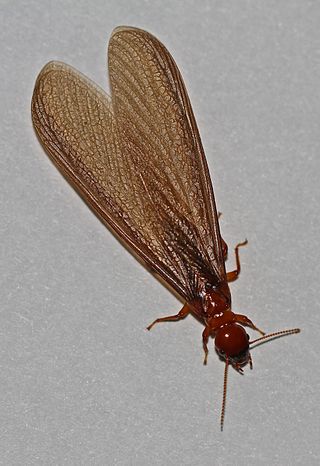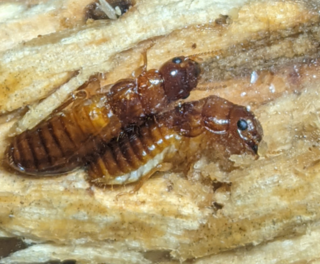
Termites are small insects that live in colonies and have distinct castes (eusocial) and feed on wood or other dead plant matter. Termites comprise the infraorder Isoptera, or alternatively the epifamily Termitoidae, within the order Blattodea. Termites were once classified in a separate order from cockroaches, but recent phylogenetic studies indicate that they evolved from cockroaches, as they are deeply nested within the group, and the sister group to wood eating cockroaches of the genus Cryptocercus. Previous estimates suggested the divergence took place during the Jurassic or Triassic. More recent estimates suggest that they have an origin during the Late Jurassic, with the first fossil records in the Early Cretaceous. About 3,106 species are currently described, with a few hundred more left to be described. Although these insects are often called "white ants", they are not ants, and are not closely related to ants.

Kalotermitidae is a family of termites, commonly known as drywood termites. Kalotermitidae includes 21 genera and 419 species. The family has a cosmopolitan circumtropical distribution, and is found in functionally arid environments.
Calcaritermes is a genus of termites in the Kalotermitidae family.

Cryptotermes is a genus of termites in the family Kalotermitidae. It is one of the economically most significant genera of drywood termites.

Neotermes is a genus of termites in the Kalotermitidae family. The genus was first described by Nils Holmgren in 1911, and the type species is Neotermes castaneus.

Incisitermes minor is a species of termite in the family Kalotermitidae known commonly as the western drywood termite. It is native to western North America, including the western United States and northern Mexico. It has been found in many other parts of the United States, all the way to the East Coast. It has been reported from Toronto. It has been introduced to Hawaii. It has been noted in China and it is not uncommon in Japan. This is an economically important pest of wooden structures, including houses. In California and Arizona alone its economic impact is estimated to be about $250 million per year.

Amitermes is a genus of termites in the family Termitidae. It is the second largest genus after Microcerotermes in the subfamily Amitermitinae with around one hundred species. Species are found in a range of habitats including deserts and rainforests. Characteristics of Amitermes soldiers include a bulbous head, sickle-shaped mandibles with a single tooth on their inner margins and cephalic glands on the front of their heads.

Cryptotermes brevis is a species of termite in the family Kalotermitidae, commonly known as the West Indian drywood termite or the powderpost termite. It is able to live completely inside timber structures or articles made of wood such as furniture without any outside source of water. It is frequently introduced into new locations inadvertently, and causes damage to the structural timbers of buildings and to wooden objects such as furniture.
Postelectrotermes militaris is a species of drywood termite of the genus Postelectrotermes. It is native to India and Sri Lanka. It is a serious pest of tea.
The Indo-Malaysian drywood termite,, is a species of dry wood termite of the genus Cryptotermes. It is found in Philippines, Australia, Papua New Guinea, Hawaii, and introduced to Sri Lanka. It is the smallest termite species in Australia, with 2.5 – 3.7mm in soldiers.
The domestic drywood termite,, is a species of dry wood termite of the genus Cryptotermes. It is native to Malaysia, Borneo, Australia, China and Sri Lanka. It is mainly a house termite and also found in cultivated areas. The presence of this termite can be identified by small heaps of tiny egg-like pellets of excreta. It is a larger termite species, with 3.25-5.90mm in soldiers. It is considered as a minor pest in Australia, but is a serious pest causing wood damage in other parts of the world.

The West Indian drywood termite,, is a species of dry wood termite of the genus Cryptotermes. It is native to Indonesia, Java and exotic to Australia, Trinidad and Tobago and Sri Lanka. It is predominantly a house termite found in natural and man-made wooden structures. Thus, this is the most commonest and most devastating drywood pest termite found in the world. It is a larger termite species, with 4.55–7.15 millimetres length in soldiers.

Blattoidea is a superfamily of cockroaches and termites in the order Blattodea. There are about 17 families and more than 4,100 described species in Blattoidea.

Archotermopsidae is a family of termites in the order Blattodea, known as dampwood termites, formerly included within the family Termopsidae. They constitute a small and rather primitive family with five extant genera and 13–20 living species. They may be a nuisance, but compared to the drywood termites (Kalotermitidae), usually do not cause extensive damage to buildings or other man-made structures. As their name implies, they eat wood that is not dried out, perhaps even rotting, and consequently of little use to humans.
Marginitermes hubbardi, commonly known as the light western drywood termite, is a species of termite in the family Kalotermitidae. It is found in Central America and desert regions of southwestern North America.
Marginitermes is a genus of termites in the family Kalotermitidae. There are at least three described species in Marginitermes.
Prorhinotermes simplex, the Cuban subterranean termite, is a species of lower termite in the genus Prorhinotermes. It is found in Colombia. Like others in its genus, it is a single-site nesting termite that moves to a new food source when theirs is gone, and it lacks a true worker caste.
Pterotermes is a monotypic genus of termites in the family Kalotermitidae. Pterotermes occidentis is the single species in the genus. This termite lives in the extremely dry conditions found in the Sonoran Desert in southwestern United States, Baja California and Mexico. It feeds on dry wood and lives entirely within a single piece of timber.

Neotermes jouteli is a species of neotropical dampwood termite in the family Kalotermitidae which is native to South Florida and surrounding West Indian nations. N. jouteli is the largest species of termite in Florida with soldiers reaching a maximum length of 13.35 mm and the winged alates around 16.05 mm.
Glyptotermes is a genus of termite in the family Kalotermitidae. With 127 species worldwide as of 2013, is the family's most speciose genus, and the second most speciose in the New World after Cryptotermes.









